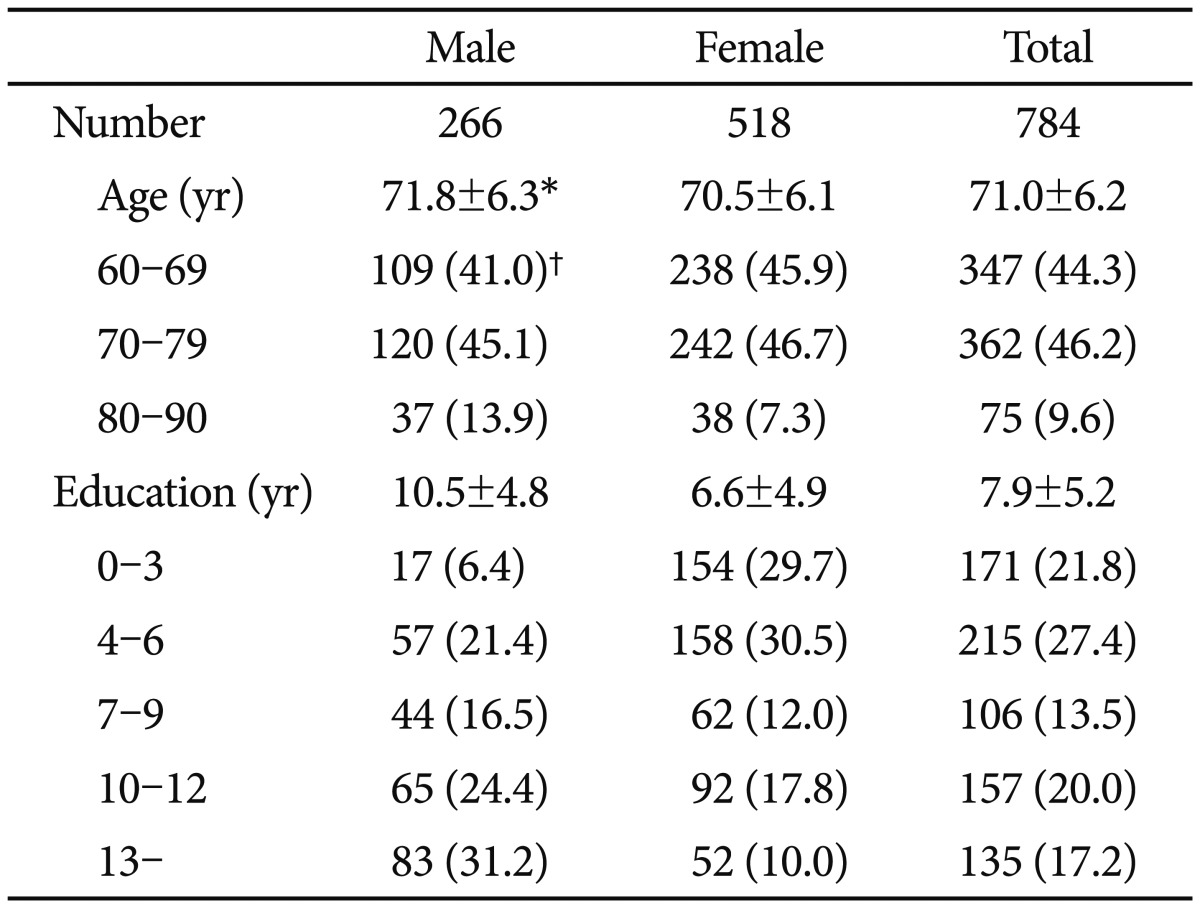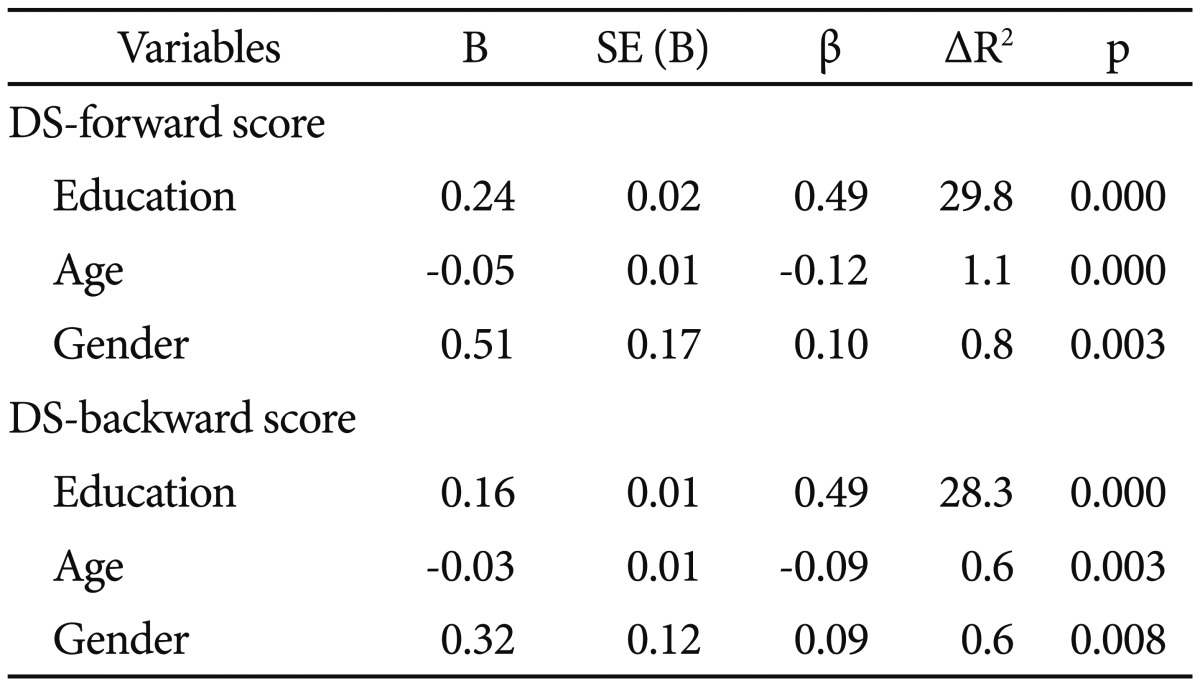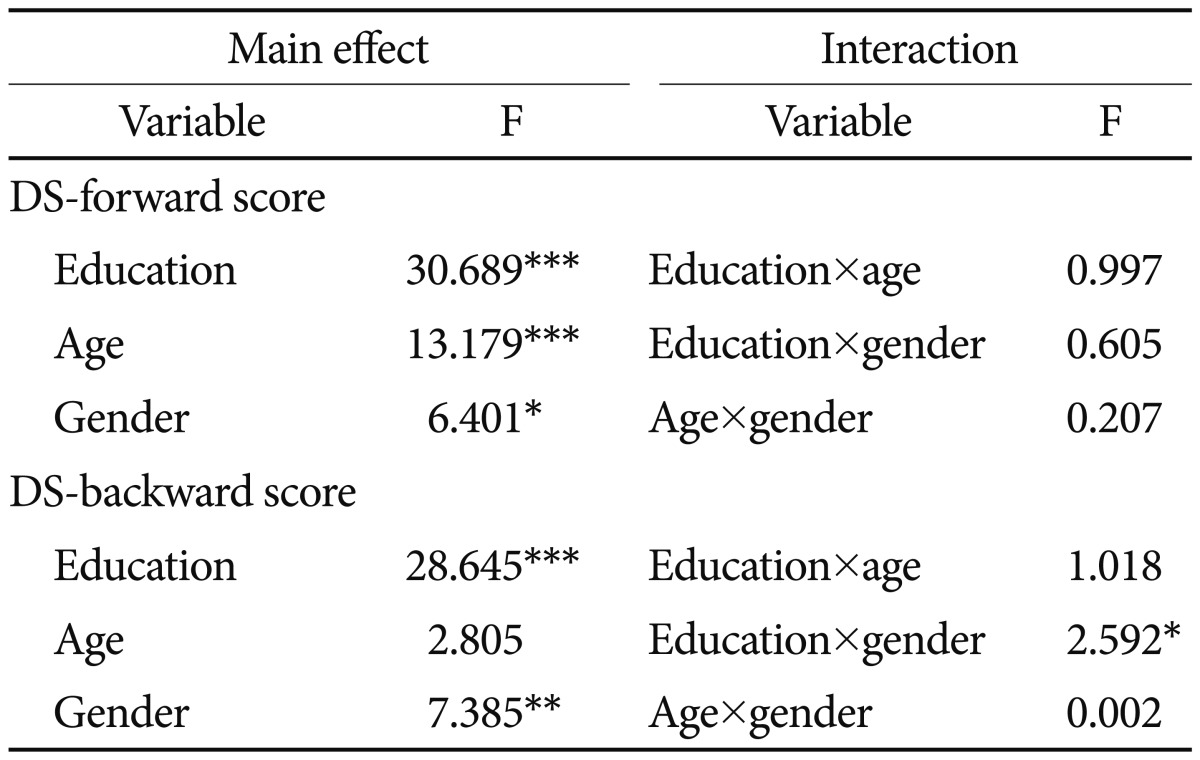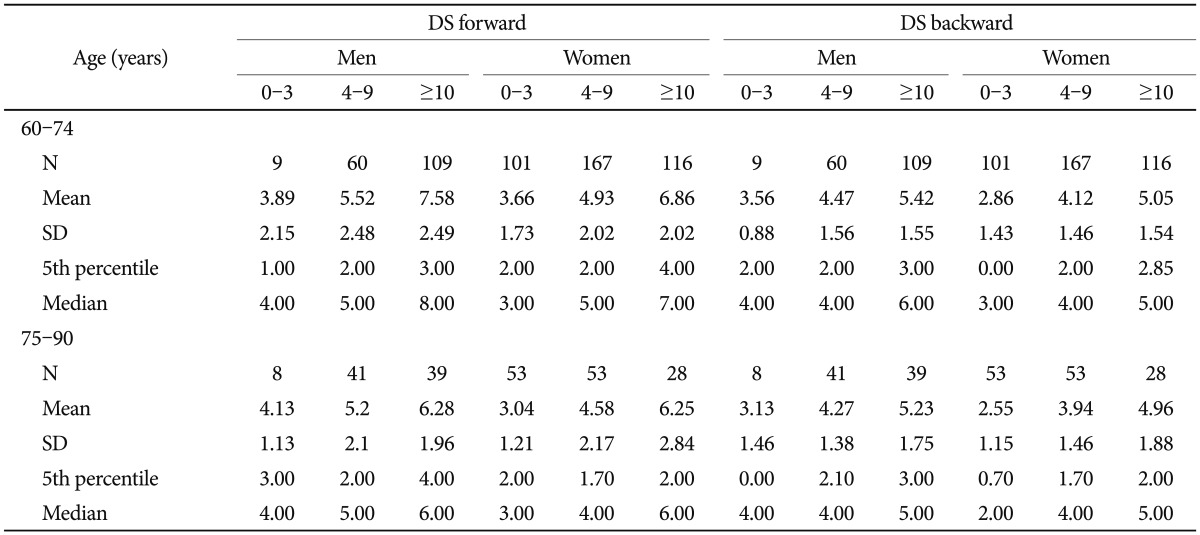Abstract
Objective
The purpose of this study was to explore the effect of demographic variables on Digit Span test (DS) performance in an educationally diverse elderly population and to provide normative information.
Methods
The DS was administered to 784 community-dwelling volunteers aged 60-90 years with an educational history of from zero to 25 years of full-time education. People with serious neurological, medical and psychiatric disorders (including dementia) were excluded.
Results
Age, education and gender were found to be significantly associated with performance on the DS. Based on the results obtained, DS norms were stratified by age (2 strata), education (3 strata), and gender (2 strata).
Conclusion
Our results on DS performance suggest that both attention and working memory are influenced by age, education and gender. The present study provides reasonably comprehensive normative information on the DS for an educationally diverse elderly population.
Keywords: Neuropsychological tests, Reference standards, Age factors, Education, Sex, Koreans
INTRODUCTION
The Digit Span test (DS) is a widely used neuropsychological measure, known as a test of attention and working memory.1-5 The DS consists of forward recall part and backward recall part for digit sequences. Each part is considered to assess somewhat different cognitive processes. Although specific cognitive components contributing to each part of the DS performance are not well-defined, the DS forward is regarded to be more related to attention and the DS backward is to working memory.1,6
The DS is very useful in clinical settings to differentiate, monitor, and describe various neuropsychiatric or cognitive disorders including dementia, depression, and malingered neurocognitive dysfunction.7-9 The DS also can be applied to assess people handicapped by illiteracy.10,11
DS performance has been found to be influenced by demographic factors. The relationship between older age and reduced performance has been consistently reported.12-14 Educational level is also known to have a positive effect on DS performance.15-17 However, the effect of gender on DS score is controversial. Some studies reported a minimal or no gender effect, suggesting that no gender corrections need to be applied to normative data,5,18 while other studies showed significantly higher DS backward performance in female than in male.19
Although several DS norms have been reported, many of them were obtained from relatively small number of elderly participants with a limited educational background.3 Most normative studies for DS performance in older people targeted mainly highly educated individuals (more than 12 years).13,14,18,20 while very limited numbers of studies investigated the influences of demographic factors and normative corrections on DS performance in elderly individuals with a poorer educational background.21 This study aimed to investigate the effects of age, education, and gender on DS performance, and to provide normative information based on an analysis of a large, educationally diverse elderly population.
METHODS
Study population
Seven hundred and eighty-four healthy people aged 60-90 years were included in this study. Research participants were recruited from among elderly individuals who participated in a community service program for the early detection and management of dementia at 4 centers located in Seoul (two public health center and two dementia or memory clinics) from January 2003 to November 2010. All participants lived independently in the community. Informed consent was obtained from each participant according to the procedures approved by the institutional review board of each center.
Psychiatrists with advanced training in neuropsychiatry and dementia research examined all participants according to the protocol in the Korean Version of the Consortium to Established a Registry for Alzheimer's disease (CERAD) clinical assessment battery.22 The battery consisted of a standardized clinical interview on demographic information, cognitive and functional status, drug inventory, depression and medical history, a cognitive state examination including the six-item Korean version of the Short Blessed test23 and a general physical and neurological examination. In addition, they interviewed reliable informants to acquire accurate information regarding cognitive and functional changes and medical history of the participants. A panel consisting of four psychiatrists with expertise in dementia research made the clinical decisions including dementia diagnosis. This panel reviewed all available raw data from the clinical evaluation.
All participants in the present sample satisfied strict inclusion criteria. Candidates with dementia or another serious medical, psychiatric, or neurological disorder that could affect mental function were excluded. Psychiatrists diagnosed dementia using the criteria detailed in the Diagnostic and Statistical Manual of Mental Disorders, fourth edition.24 All participants possessed adequate hearing, although some required a hearing aid. Individuals with minor physical abnormalities (e.g., diabetes with no serious complications, essential hypertension, mild hearing loss, etc.) were included in the study.
Measurements
The DS in the standardized version of the Wechsler Adult Intelligence Scale-Revised11 was used in the present study. Trained psychologists administered the DS at each of the four sites. The DS was presented beginning with a length of 3 in forward or 2 in backward. In the DS forward, the participant had to listen to a digit span that keep to the speed of one digit per second and repeat it forward. On the contrary to DS forward, in the DS backward, the participant had to listen and repeat span backward. Two trials were presented at each length. Test was halted when participant failed to either trial at equal digit length.
Statistical analysis
Stepwise multiple linear regression analysis was used to assess the relative contributions of age, education, and gender on test scores. Age and education were entered as continuous variables and gender was coded as 0 or 1 for female and male, respectively.
A series of 2×5×2 analyses of variance (ANOVA) was also performed to determine any main effects and interaction of age (60-74, 75-90 years), education (0-3, 4-6, 7-9, 10-12, and ≥13 years) and gender on the tests. Post hoc contrasts with Tukey's method were conducted when any effect of age, education and gender was determined to be significant by ANOVA at the p<0.05 level.
RESULTS
Demographic characteristics
The demographic characteristics of 784 participants are presented in Table 1. The mean age of the male participants (71.8 years) was slightly higher than that of the female participants [70.5 years; t(782)=-3.04, p<0.01]. The mean years of education was also much higher in the male group (10.5 years) than in the female group [6.6 years; t(782)=-10.67, p<0.001].
Table 1.
Demographic characteristics of participants

*result represents mean±standard deviation, †number (percent)
Effects of age, education, and gender on test scores
Stepwise multiple regression analysis revealed that age, education and gender affected the test scores significantly. Among the demographic variables, education accounted for the greatest proportion of the score variance of both DS forward and backward performances (Table 2). Education accounted for 29.8% and 28.3% of the variance for DS forward and backward scores, respectively. Age accounted for 1.1% and 0.6% and gender accounted for 0.8% and 0.6% of DS forward and backward scores, respectively.
Table 2.
Stepwise multiple linear regression of age, education and gender on digit span (DS) score

Age and education were entered as continuous variables, and sex was coded as 0 and 1 for female and male, respectively. B: regression coefficient, SE (B): standard error of B, β: standardized regression coefficient, ΔR2: percent variance explained by each variable
Three-way ANOVA was also performed to determine any main effects or interactions among demographic variables on test scores. Age [F(1, 769)=13.18, p<0.001] , education [F(4, 769)=30.69, p<0.001] and gender [F(1, 769)=6.40, p<0.05] were found to have significant effects on DS forward scores. Education [F(4, 769)=28.65, p<0.001] and gender [F(1, 769)=7.39, p<0.01] were found to have significant effects on DS backward scores. As shown in Table 3, no interaction between age, education and gender was found for DS forward test, however ANOVA's revealed significant interaction between education and gender for DS backward test.
Table 3.
Analysis of variance for main effects and interactions between education, age, and gender on digit span score

Age is categorized as '60-74, 75-90'; education as '0-3, 4-6, 7-9, 10-12, and ≥13 years'; respectively. *p<0.05, **p<0.01, ***p<0.001 by 2×5×2 analysis of variance (ANOVA). DS: digit span
Because education was found to affect scores of DS forward and backward, educational groups (i.e., 0-3, 4-6, 7-9, 10-12, ≥13 years of education) were compared by using the post hoc contrasts. In terms of DS forward, significant differences were found between the 0-3 year group and all ≥4 year groups (i.e., 4-6, 7-9, 10-12, ≥13 years), between the 4-6 and 10-12 year groups, and between the 4-6 and ≥13 year group, whereas no significant differences were observed between the 4-6 and 7-9, and between the 10-12 and ≥13 year group. In term of DS backward, significant differences were found between the 0-3 year group and all ≥4 year groups (i.e., 4-6, 7-9, 10-12, ≥13 years), between the 4-6 year group and all ≥7 year groups (i.e., 7-9, 10-12, ≥13 years), and between the 7-9 and ≥13 year group, whereas no significant differences were observed between the 7-9 and 10-12, and between the 10-12 and ≥13 year group.
Normative data
On the basis of the results for the effects of demographic variables, we decided to stratify DS forward and backward scores by age, education and gender (Table 4). Tables composed of age strata with midpoint ages occurring at 15-year intervals (i.e., 67 and 82 years of age, respectively for two strata) were developed as shown in Table 4. The educational groups were divided into three strata (i.e., 0-3, 4-9, and ≥10 years of education) for DS forward and DS backward scores. Strata of education were determined considering the results from the post hoc contrasts between the five educational groups, and the number of participants within each cell. The normative scores of the DS stratified by demographic variables were shown in the forms of a mean, a standard deviation, a median and a range of the 5th percentile (Table 4).
Table 4.
Normative data of digit span score: mean, standard deviation, median and range of the 5th percentile

SD: standard deviation, DS: digit span
DISCUSSION
The present investigation was conducted to examine the effect of demographic factors on the performance of the DS and to provide normative information in a large and educationally diverse elderly population to allow clinicians and researchers to interpret test results better. Lower educational level, older age, and female gender were associated with poorer performances of both DS forward and backward. Based on the results for the influence of demographic variables on DS performance, normative data were stratified by education, age and gender.
The significant influence of education on DS performances found in our study has already been reported by many previous studies.13,16,18,21,25,26 In regard of the degree of influences, however, there are some differences between studies. Some studies13,16 showed relatively small education effect (R2: about 5-8%), while other ones18,21 had bigger education effect (R2: greater than 23%) like ours. This discrepancy among studies probably relates to the range of educational levels of study participants. The studies for subjects with very narrow range of educational background showed relatively small educational influence on both DS forward and backward performance,13,16 whereas those for the subjects with wide range of educational background like ours had greater education effect.18,21
In terms of age effect on the DS, our findings were in line with those from most of previous studies.13,16,18,21,25 Similar to the degree of education effect above mentioned, however, the magnitude of age effect was also very diverse probably depending on the age distribution of study participants. The studies including young adults as well as older individuals revealed greater age influence (R2: about 10%)16,25 compared to those including only older subjects like ours (R2: about less than 1%).21 A study conducted only for oldest old individuals (age range 85-95 years) did not even show any age effect for both DS subtests.26
In our study, male performed significantly better than female in both DS forward and backward test, but the degree of gender effect was not so big (R2: only 0.8% for DS forward and 0.6% for DS backward). Although some previous studies also reported small but significant gender effect on both DS subtests or on DS backward performance,16,18 other studies did not found any gender effect on DS performances.21,25 Given very small effect size, statistical power issue related to sample size as well as population characteristics may partially explain the difference between studies.
In addition to the main effects of education and gender, ANOVA revealed an interaction between gender and education for the DS backward test indicating that DS backward scores of women decline more steeply than that of men with decreasing educational level. The better performance on the DS backward test by poorly educated male elderly than female elderly individuals might be explained by differences in their social roles. Male elderly persons with little formal education were more likely to have opportunities for intellectual stimulation via occupational activities than poorly educated female elderly persons who are usually devoted to housework, as indicated in our previous work.27
In the present study, normative data was stratified by age, education and gender considering the effect of demographic variables on DS performance. We were able to provide accurate normative data with adequate numbers of subjects for most normative subgroups. However, sample numbers of male with very low educational level (i.e., 0-3 years of education in Table 4) was still limited in size. Therefore, users should exercise caution when the test scores of such individuals are interpreted.
The study participants were recruited from mainly Seoul area, so it is hard to regard these elderly as representative of whole Korean elderly. However, the cognitive test score of Korean elderly is not associated with place of residence, and after controlling the effect of age and education, the difference between different area usually disappears.28 Moreover, there are lots of elderly in Seoul who were moved from rural area, so study participants in this study might cover both characteristics of urban and rural area.29
In conclusion, our results on the DS performances suggest that both attention and working memory are influenced by age, education and gender. Moreover, education had a greater effect than age and gender. We provide reasonably comprehensive normative data of the DS for an educationally diverse elderly population. Given most previously published norms have been largely based on the highly educated elderly,16,25 the normative information presented in this report can be very helpful to properly interpret DS scores of older people, especially those with a poorer educational background.
Acknowledgments
This study was supported by a grant from the Korea Healthcare Technology R & D Project, Ministry of Health, Welfare & Family Affairs, Republic of Korea (grant No. A092145).
References
- 1.Banken JA. Clinical utility of considering digits forward and digits backward as separate components of the Wechsler Adult Intelligence Scale-Revised. J Clin Psychol. 1985;41:686–691. [Google Scholar]
- 2.Johnstone B, Erdal K, Stadler MA. The Relationship between the Wechsler Memory Scale Revised (WMS-R) Attention Index and Putative Measures of Attention. J Clin Psychol Med Settings. 1995;2:195–204. doi: 10.1007/BF01988643. [DOI] [PubMed] [Google Scholar]
- 3.Lezak MD. Norms for Growing Older. Dev Neuropsychol. 1987;3:1–12. [Google Scholar]
- 4.Ryan JJ, Lopez SJ, Paolo AM. Digit span performance of persons 75-96 years of age: Base rates and associations with selected demographic variables. Psychol Assess. 1996;8:324–327. [Google Scholar]
- 5.Orsini A, Chiacchio L, Cinque M, Cocchiaro C, Schiappa O, Grossi D. Effects of age, education and sex on two tests of immediate memory: a study of normal subjects from 20 to 99 years of age. Percept Mot Skills. 1986;63:727–732. doi: 10.2466/pms.1986.63.2.727. [DOI] [PubMed] [Google Scholar]
- 6.Anstey KJ, Smith GA. Interrelationships among biological markers of aging, health, activity, acculturation, and cognitive performance in late adulthood. Psychol Aging. 1999;14:605–618. doi: 10.1037//0882-7974.14.4.605. [DOI] [PubMed] [Google Scholar]
- 7.Botwinick J, Storandt M, Berg L. A Longitudinal, behavioral study of senile dementia of the Alzheimer type. Arch Neurol. 1986;43:1124–1127. doi: 10.1001/archneur.1986.00520110024008. [DOI] [PubMed] [Google Scholar]
- 8.Austin MP, Ross M, Murray C, O'Carroll RE, Ebmeier KP, Goodwin GM. Cognitive function in major depression. J Affect Disord. 1992;25:21–29. doi: 10.1016/0165-0327(92)90089-o. [DOI] [PubMed] [Google Scholar]
- 9.Mathias CW, Greve KW, Bianchini KJ, Houston RJ, Crouch JA. Detecting malingered neurocognitive dysfunction using the reliable digit span in traumatic brain injury. Assessment. 2002;9:301–308. doi: 10.1177/1073191102009003009. [DOI] [PubMed] [Google Scholar]
- 10.Kurt P, Yener G, Oguz M. Impaired digit span can predict further cognitive decline in older people with subjective memory complaint: a preliminary result. Aging Ment Health. 2011;15:364–369. doi: 10.1080/13607863.2010.536133. [DOI] [PubMed] [Google Scholar]
- 11.Wechsler D. WMS-R: Wechsler Memory Scale-Revised: Manual. San Antonio, TX: Psychological Corp., Harcourt Brace Jovanovich; 1987. [Google Scholar]
- 12.Woods DL, Kishiyama MM, Yund EW, Herron TJ, Edwards B, Poliva O, et al. Improving digit span assessment of short-term verbal memory. J Clin Exp Neuropsychol. 2010 Aug 04;:1–11. doi: 10.1080/13803395.2010.493149. [Epub ahead of print] [DOI] [PMC free article] [PubMed] [Google Scholar]
- 13.Gregoire J, Van der Linden M. Effect of age on forward and backward digit spans. Aging Neuropsychol Cogn. 1997;4:140–149. [Google Scholar]
- 14.Palmer BW, Boone KB, Lesser IM, Wohl MA. Base rates of "impaired" neuropsychological test performance among healthy older adults. Arch Clin Neuropsychol. 1998;13:503–511. [PubMed] [Google Scholar]
- 15.Kaufman AS, Mclean JE, Reynolds CR. Sex, race, residence, region, and education differences on the 11 WAIS-R subtests. J Clin Psychol. 1988;44:231–248. doi: 10.1002/1097-4679(198803)44:2<231::aid-jclp2270440224>3.0.co;2-j. [DOI] [PubMed] [Google Scholar]
- 16.Anstey KJ, Matters B, Brown AK, Lord SR. Normative data on neuropsychological tests for very old adults living in retirement villages and hostels. Clin Neuropsychol. 2000;14:309–317. doi: 10.1076/1385-4046(200008)14:3;1-P;FT309. [DOI] [PubMed] [Google Scholar]
- 17.Ardila A, Rosselli M. Neuropsychological characteristics of normal aging. Dev Neuropsychol. 1989;5:307–320. [Google Scholar]
- 18.Pena-Casanova J, Quinones-Ubeda S, Quintana-Aparicio M, Aguilar M, Badenes D, Molinuevo JL, et al. Spanish Multicenter Normative Studies (NEURONORMA Project): norms for verbal span, visuospatial span, letter and number sequencing, trail making test, and symbol digit modalities test. Arch Clin Neuropsychol. 2009;24:321–341. doi: 10.1093/arclin/acp038. [DOI] [PubMed] [Google Scholar]
- 19.Singh D, Joska JA, Goodkin K, Lopez E, Myer L, Paul RH, et al. Normative scores for a brief neuropsychological battery for the detection of HIV-associated neurocognitive disorder (HAND) among South Africans. BMC Res Notes. 2010;3:28. doi: 10.1186/1756-0500-3-28. [DOI] [PMC free article] [PubMed] [Google Scholar]
- 20.Ivnik RJ, Malec JF, Smith GE, Tangalos EG, Petersen RC, Kokmen E, et al. Mayo's Older Americans normative studies: WAIS-R norm for ages 56 to 97. Clin Neuropsychol. 1992;6:1–30. [Google Scholar]
- 21.Kang YW, Chin JH, Na DL. A normative study of the digit span test for the elderly. Korean J Clin Psychol. 2002;21:911–922. [Google Scholar]
- 22.Lee JH, Lee KU, Lee DY, Kim KW, Jhoo JH, Kim JH, et al. Development of the Korean version of the Consortium to Establish a Registry for Alzheimer's Disease Assessment Packet (CERAD-K): clinical and neuropsychological assessment batteries. J Gerontol B Psychol Sci Soc Sci. 2002;57:P47–P53. doi: 10.1093/geronb/57.1.p47. [DOI] [PubMed] [Google Scholar]
- 23.Lee DY, Yoon JC, Lee KU, Jhoo JH, Kim KW, Lee JH, et al. Reliability and validity of the Korean Version of Short Blessed Test (SBT-K) as a dementia screening instrument. J Korean Neuropsychiatr Assoc. 1999;38:1365–1375. [Google Scholar]
- 24.American Psychiatric Association. Diagnostic and Statistical Manual of Mental Disorders. 4th Edition. Washington, DC: American Psychiatric Association; 1994. [Google Scholar]
- 25.Fine EM, Kramer JH, Lui LY, Yaffe K Study of Osteoporotic Fractures SOF Research Group. Normative data in women aged 85 and older: verbal fluency, digit span, and the CVLT-II short form. Clin Neuropsychol. 2012;26:18–30. doi: 10.1080/13854046.2011.639310. [DOI] [PMC free article] [PubMed] [Google Scholar]
- 26.Monaco M, Costa A, Caltagirone C, Carlesimo GA. Forward and backward span for verbal and visuo-spatial data: standardization and normative data from an Italian adult population. Neurol Sci. 2013;34:749–754. doi: 10.1007/s10072-012-1130-x. [DOI] [PubMed] [Google Scholar]
- 27.Lee DY, Lee KU, Lee JH, Kim KW, Jhoo JH, Kim SY, et al. A normative study of the CERAD neuropsychological assessment battery in the Korean elderly. J Int Neuropsychol Soc. 2004;10:72–81. doi: 10.1017/S1355617704101094. [DOI] [PubMed] [Google Scholar]
- 28.Yeo HY, Lee KY, Lee GH, Jhoo JH, Kim KW, Lee JH, et al. The effects of sociodemographic variables on MMSE - K scores of the elderly in urban and rural area. Korean J Psychopathol. 1998;7:72–80. [Google Scholar]
- 29.Lee DY, Lee KU, Lee JH, Kim KW, Jhoo JH, Youn JC, et al. A normative study of the Mini-Mental State Examination in the Korean elderly. J Korean Neuropsychiatr Assoc. 2002;41:508–525. [Google Scholar]


